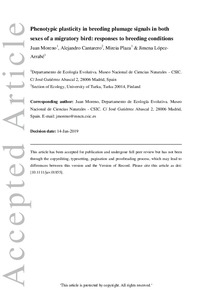Phenotypic plasticity in breeding plumage signals in both sexes of a migratory bird: responses to breeding conditions
Juan Moreno; Alejandro Cantarero; Mireia Plaza; Jimena López-Arrabé
https://urn.fi/URN:NBN:fi-fe2021042821232
Tiivistelmä
Adaptive phenotypic plasticity may respond to present ambient conditions. Sexual and social signals in both sexes may express phenotype performance. Plumage signals that change discontinuously allow relating discrete variation to previous performance. Both sexes of the pied flycatcher Ficedula hypoleuca present white patches on the wings and on the forehead, which constitute sexual and social signals. Forehead patches are moulted together with body plumage in Africa, while wing patches are partly moulted in Africa and partly in the breeding area soon after breeding. We studied individual inter‐year changes (corrected for regression to the mean) in the size of forehead and wing patches of both sexes in seven years for females or six years for males in two nearby study areas in central Spain. We found that initial signal extent strongly delimits the possible subsequent changes negatively. There is a negative association of male age with forehead patch changes. Cold and rainy springs are associated in females with decreases in both patch areas and vice versa, while no association with climate is observed in male wing patch changes. Cold pre‐breeding conditions predict positive changes in female wing and male forehead patches. Breeding success is positively associated with forehead patch changes in females. Late‐breeding males experience more positive changes in forehead patch size than early‐breeding males. Some of these trends can be explained by variable costs of breeding in certain conditions for subsequent signal production and/or maintenance, while absence of trends in some cases may be explained by sex differences in costs of breeding and interactions with phenotypic quality of breeders.
Kokoelmat
- Rinnakkaistallenteet [27094]
